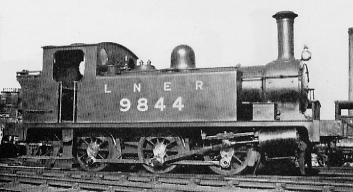The Reid J88 (NBR Class F) 0-6-0T Locomotives

Reid designed his Class F (LNER J88) 0-6-0T locomotives for dock shunting duties on the North British Railway (NBR) in 1904. After the tenure of Drummond, the J88s introduced a number of notable differences, including right hand drive, outside cylinders, and the lack of smokebox wing plates. The J88 proved to be a successful design, and the NBR adopted the class as their standard light shunting locomotive. With only small modifications, a total of thirty five were built between 1904 and 1919 in five batches. The first two batches (1904-5) were built with non-lifting injectors, and safety valves mounted on the dome. Combination injectors were introduced on the 1909 batch of six, and the safety valves were mounted on the firebox for the last two batches (ten in 1912 and seven in 1919). Steam brakes were standard on all batches.
The twelve locomotives built in the 1904 and 1905 batches were rebuilt in 1925 with new boilers. These boilers had Ross pop safety valves mounted on the firebox and combination injectors. This was the last time that the NBR tradition of rebuilding locomotives when they needed new boilers, was followed. All later boiler renewals were by fitting or swapping boilers. Completely new boilers were fitted to J88s in 1929-33, 1950-51 and 1954-5.
The first twelve locomotives also differed from the other J88s in their frames and buffers. They had slotted frames instead of the solid plates used on the later J88s. They were also built with dumb buffers, but these had been replaced before Grouping (1923).
The J88s were typically allocated to sheds which were responsible for dock workings. They were also used for the shunting of industrial sidings in the industrial Lowlands, where sharp curves and short shunting heads were common. Unusually, they tended to work more trip workings as they aged.
Their allocations rarely changed and in 1935 was: St. Margaret's (9), Eastfield (8), Thornton (7), Kipps (4), Polmont (3), Stirling (2), and Haymarket (2).
The entire class survived into Nationalisation (1948). The first withdrawal was No. 68341 which was scrapped in November 1954 after falling into Kirkcaldy harbour. This appears to have happened after it lost control on a steep bank, whilst trying to pull a nineteen wagon train of wood (twelve was the permitted length). With the introduction of large numbers of diesel shunters during the 1950s, regular withdrawals started only a year later in 1955. The class became extinct in December 1963.
Technical Details
| Cylinders (x2): | (outside) | 15x22in. |
| Motion: | Stephenson | |
| Valves: | Slide | |
| Boiler: | Diameter (max): | 3ft 10in |
| Length: | 8ft 8.5in | |
| Boiler Pressure: | 130psi | |
| Diagram No: | 87 | |
| Heating Surface: | Total: | 651.2 sq.ft. |
| Firebox: | 65.7 sq.ft. | |
| Tubes: | 585.5 sq.ft. (142x 1.75in dia.) | |
| Grate Area: | 14.5 sq.ft. | |
| Wheels: | 3ft 9in | |
| Total Wheelbase: | 11ft | |
| Tractive Effort: | (at 85%) | 12,155 lb |
| Length: | 26ft 6.75in | |
| Weight: | 38t 14cwt | |
| Max. Axle Load: | 15t 12cwt | |
| Water Capacity: | 850 gallons | |
| Coal Capacity: | 2t 1cwt |
Preservation
None of the J88s survived into preservation.
Models
Falcon Brassworks sell an etched 4mm kit of the J88.